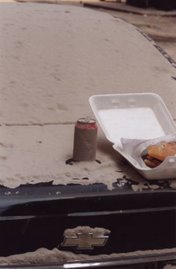10,000 BC Bread
I just finished with three soup tonic recipes, and it reminded me "Bread, Beer and Soup" the cross-cultural staffs of life began some 10,000 years ago. It had taken about 10,000 years to go from rice - cultivation of which began in dim pre-history - to bread, beer and soup. I personally wonder if 10,000 years hence we'll have any rice left.
So, bread is a global concept, and in my opinion, very little has changed since 10,000 years ago, with the exception of the use of yeast in breadmaking about 5,000 years ago.
I got to comparing bread recipes across cultures, and across time. The oldest breads would be unleavened of course, and we are told that Indian Naan was the oldest bread, together with Pita. Well, Naan, it is generally accepted, is a leavened bread, so they meant Roti's aka Chapati's.
As these are unleavened flat breads, the Roti is much like the Mexican Tortilla and the Middle Eastern Pita and the Italian Pizza. Only the Mexican Tortilla is still made by some rare souls today with some hint of authenticity to the original preparation of the corn; only in some places of the Himalayas have they preserved the authenticity of the preparation of the wheat. I have read that archeologists found "Italians as far back as Neolithic man were grinding grain between stones, adding water to make a mush and leaving it to sit overnight to dry. It is thought that they then cooked it over coals or stones, and the focaccia was born."
Here's a very basic recipe for wheat flat bread, minus the grinding of grain between stones accompanied by the the gnashing of teeth. Now I suggest the use of sea water as an allowable substitute for salt and water, but I'd be foolhardy to put that stuff in my mouth in this modern era. It's become a toxic version of Ice-Nine. So use regular water and leave out the salt.
Ingredients:
1 cup wheat flour
2 tbsp animal fat
1 cup water
Extra wheat flour on hand
Method:
In a mixing bowl, take 1 cup flour and add 1 tbsp animal fat. Rub the flour between your palms so that the fat becomes incorporated the dough. Add water, a little at a time and knead the flour to make a dough, which will be stiff.
Cover the bowl with a towel and leave it for 30 minutes. Take a small portion of the dough and roll it into a smooth ball between your palms. Flatten the ball of dough by pressing it in a separate bowl of whole wheat flour. Dust the flat dough liberally on both sides with the flour.
Place the dough on a flat surface and with something that looks like a neolithic rolling pin roll out a 6 inch flat circle. Use circular movements of the rolling pin to get a perfect circle which is evenly thick all over. The bread dough should be as thin as a slice of processed cheese single. If the dough gets stuck to the rolling pin while rolling, dust it with more flour.
Now take the remaining 1 Tb of animal fat and brush it onto the flat circle, then made a radius cut, and start rolling up the dough in a circle. You will end with a cone, place it on the base and poke the peak down into the base. Leave for an hour.Now take each roll and flatten again and roll out again.
Roasting the Bread
Heat a flat iron griddle, reduce the heat to medium and flip the rolled out the bread circle on the griddle. Cook it on one side for about 10-15 seconds and flip it over before you start to see big brown spots (i.e. a tad deliberately undercooked).
Cook on the other side for another 15-20 seconds or until you see brown spots to indicate the bread is cooked on this side. Keep turning the bread on the griddle so that it does not stick. Finally, flip the bread again on the first side and finish cooking for another 5-10 seconds. Serve I am sure they also brushed the bread with a little hot animal fat if cave-daddy had been bringing home the bacon on a regular basis.

0 comments:
Post a Comment